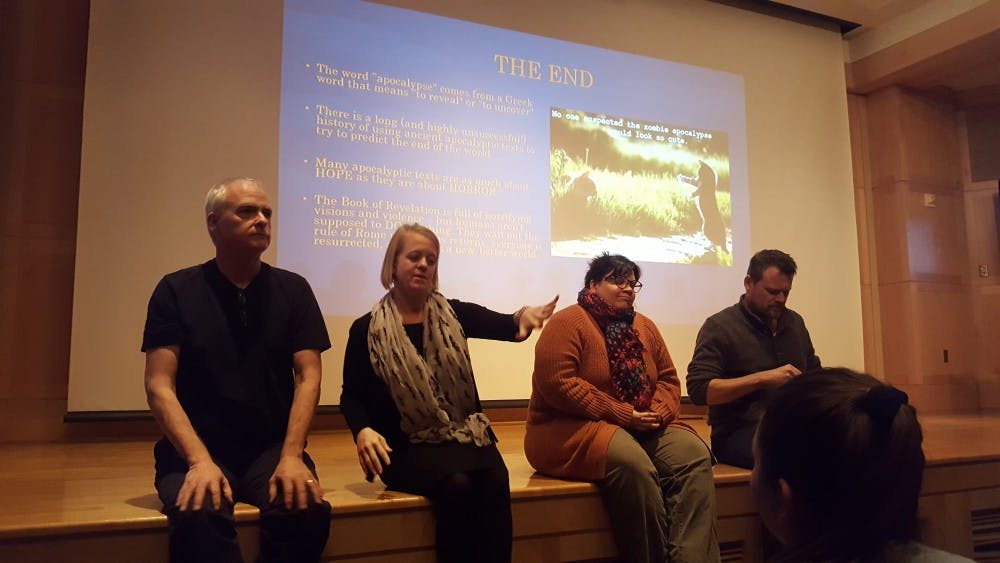Halloween-inspired topics discussed during religion and philosophy panel

For six years the Department of Philosophy and Religion at Central Michigan University has been hosting a Halloween-themed lecture based on religion.
Each year, four philosophy and religion professors share ghoulish stories that are backed by cultural and religious beliefs, informing students about the history hidden behind scary stories.
On Oct. 23 this Halloween panel discussion was held in the Park Library auditorium, getting students into the spirit of the holiday.
Evangelism and hell houses
One of the four professors, Sarah Moslener, started the discussion by discussing hell houses and Evangelism.
Evangelism is a form of Christianity where its followers seek a very strong relationship with Christ, she said. According to Moslener, followers have been known to span from either side of the political and social spectrum.
Hell houses are very much like the typical haunted house attractions that people visit during the month of October. However, instead of people dressed as monsters and ghouls jumping out at people as they walk by, scenes of gruesome, realistic events are presented to viewers.
The first hell house was created by Evangelist members of Trinity Church in the 1970s. Most hell house Evangelists were conservatives, Moslener said.
The point of hell houses is to help those who participate commit themselves to Christ, using fear of realistic and gruesome situations to motivate them.
“They’re meant to be traumatic in a realistic way,” Moslener said. “Unlike other haunted houses, they want to be persuasive.”
Apocalypse
Another topic discussed in the lecture was the apocalypse, which was examined using two different religious viewpoints.
Theology Professor Guy Newland dipped briefly into the Buddhist’s apocalyptic prophecy.
Newland said the Buddhist tradition teaches that everything ever created is impermanent, meaning that everything -- including the Buddhist tradition itself -- will eventually vanish.
This prophecy was believed to be true because there was mention of it in ancient scriptures, which predicted the rapid decline of Buddhism. Another belief that encourages the apocalyptic prophecy was the introduction of female monastics (Buddhist monks). The Buddha is said to have claimed that the Buddhist tradition was going to disappear within 500 years instead of 1,000 years because of the female monastics.
More than 1,000 years later the Buddhist tradition has shifted from believing that invaders would cause the Buddhist tradition to end, to realizing that it was more of a inner-self conflict that would be the end of Buddhism.
On the other side of the spectrum, Assistant Professor of Religion Kelly Murphy spoke about the Book of Revelation of Christianity.
Murphy first visited the true definition of the word “apocalypse," which means "to uncover," she said.
“It doesn’t mean ‘the end of the world’,” Murphy said. “It’s almost like a bride taking off her veil at a wedding. You get to see what she really looked like. Apocalyptic thinking considers that the world we see around us is veiled.”
According to Murphy, many apocalyptic thinkers believe that God will come down and lift the "veil" to show what the world is truly supposed to look like.
In apocalyptic books -- like the Book of David and the Book of Revelation -- the resurrection of the dead signaled that Christ had returned.
The end of the Book of Revelation depicts the creation of a new world as Christ goes down to earth and slays the evil of the world that is represented as a seven-headed dragon.
Near-death experiences
Professor Michael Kinsella touched on the subject of near-death experiences and shared-death experiences.
Near-death and shared-death experiences are often looked at as being a rare look into the afterlife, Kinsella said. The idea of these experiences was popularized more than 40 years ago by Raymond Moody.
"Many people who claim to have had one of these experiences have come close to dying or in situations of great danger," Kinsella said.
Those who claimed to have had a near-death experience say that they have experienced the following phenomena:
- Out-of-body experiences.
- Felt like they were entering a tunnel.
- Meeting deceased loved ones.
- Encountering mystical light that often seemed inviting and “loving.”
- Have seen their life flash before their eyes, or have seen their own life from someone else’s eyes.
- Being instructed to return to their physical body.
- A welcoming party
Although many people are curious to find out more about these experiences, skeptics believe that the experiences can be explained as hallucinations that arise from the fear of death.
Despite skeptical reasoning, many still believe in these experiences due to veridical perceptions, which are perceptions people have while they are seemingly "out-of-body."
For example, someone who is out-of-body may witness a conversation that could have happened in a separate room than where their body physically is, and later report what was said when they are back in their physical body.
“After the research that I have done there is still that question of ‘are these reports of near-death experiences true or are they interpreted as such due to the popularity of them?’” Kinsella said. “But the debate goes on -- I don’t have an answer -- so this is to be continued.”






